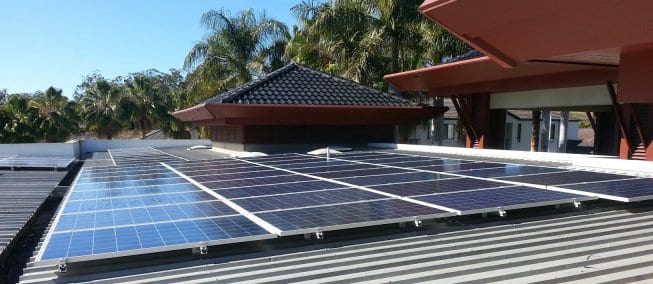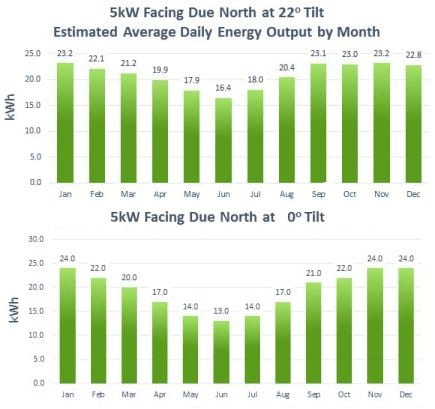Solar panels of a flat roof – the Pros and Cons
Installing solar panels on the Gold Coast flat to a very low pitch or flat roof is not usually recommended as when solar panels are installed this way the self cleaning capability of the solar panels is diminished. What tends to happen is the dirt that builds up on the solar panels is not effectively washed off by the rain, so the system may not function quite as efficiently and will possibly require additional cleaning.

The self cleaning aspect is certainly a detrimental point about installing solar panels flat to a flat or low pitched roof, however the only other option is to install the solar panels on tilt framing to achieve the desired tilt and the benefits this provides (higher power output and self cleaning). Tilt framing certainly has its benefits however there are drawbacks which need to be considered as follows:
- Solar panels installed on tilt framing put a much higher wind loading on the solar panels and roof.
- Solar panels installed on tilt framing shade the roof behind the panels. This means that a second row of solar panels cannot be installed close to the row in front as the front row will shade the back row, and shading is very detrimental to the performance of solar panels. This means that more space is required on the roof – if space is of the premium then this is a major issue.
- Tilt framing is more expensive and time consuming to install than installing solar panels flat to a roof.
Solar Power Production On Flat Roof
 An important point to take into consideration when installing solar panels on a flat roof is the performance of the solar panels either installed on tilt or installed flat. Over the entire year the difference in solar production from a system installed at a pitch between 22 and 30o is around 10% higher than a system installed directly to a flat roof. A point to keep in mind here is that this 10% difference in power is not evenly spread over the year as can be seen on the chart to the right.
An important point to take into consideration when installing solar panels on a flat roof is the performance of the solar panels either installed on tilt or installed flat. Over the entire year the difference in solar production from a system installed at a pitch between 22 and 30o is around 10% higher than a system installed directly to a flat roof. A point to keep in mind here is that this 10% difference in power is not evenly spread over the year as can be seen on the chart to the right.
This chart shows that a 5 kW solar power system installed flat to a roof in the middle of winter produces around 3 kWh less power per day than the tilted comparison, but in the summer months it actually produces slightly more power than the tilted system!
On the Gold Coast and Queensland in general this is good to know as one of the main loads that solar power is used to offset is air conditioning, which always tends to be working that much harder over the summer months, so system installed flat to the roof would work very well to cover this type of summer load.
At the end of the day a 10% difference in power production is not a massive difference, especially when roof space is at a premium. When installing solar panels on tilt framing you can only install around half the solar panels you could if the system was installed flat due to the additional space required to ensure the rows of solar panels don’t throw shade on the solar panels behind. If you are wanting to maximise the amount of power produced by a system being able to nearly double the number of solar panels for an efficiency loss of around 10% makes good sense.
Flat Roof Installations of Solar Panels – What’s Best?
The best option for you really depends on your unique situation. As discussed the following points are the main things that need to be considered:
- Is roof space at a premium and you want to get as much power as possible out of the available space? Solar panels installed flat to the roof may be the best option.
- What time of year is the solar power most required? If it’s over the winter months then a tilted solar panel is going to produce a lot more power in winter than a solar panel installed flat. If it’s in the summer months for air conditioners and cooling loads then solar panels installed flat will work great, solar panels installed flat are at the best angle to provide maximum returns over the summer months (for the Gold Coast & Queensland anyway).
- Do you have a large amount of roof space and there’s plenty of room for your solar panels to be installed on tilt? Tilt may be the best option for you.
- Are you after the fastest ROI (Return On Investment) possible? Installing solar panels flat to the flat roof will provide the fastest ROI as the installation and material costs are much cheaper than a tilted system.
- After the highest returns in the long term and you have the available roof space? A solar power system installed on tilt framing will be the best option as a system tilted to the north at a pitch between 22 and 30o will produce around 10% more power than a system installed directly to a flat roof.
So at the end of the day the correct answer all depends on your unique requirements. if you are anywhere near the Gold Coast we can certainly assist you; feel free to contact us here for expert advice from the Gold Coast’s solar power experts – Gold Coast Solar Power Solutions.
Got A Question About Solar Power? Click Here For Answers!

